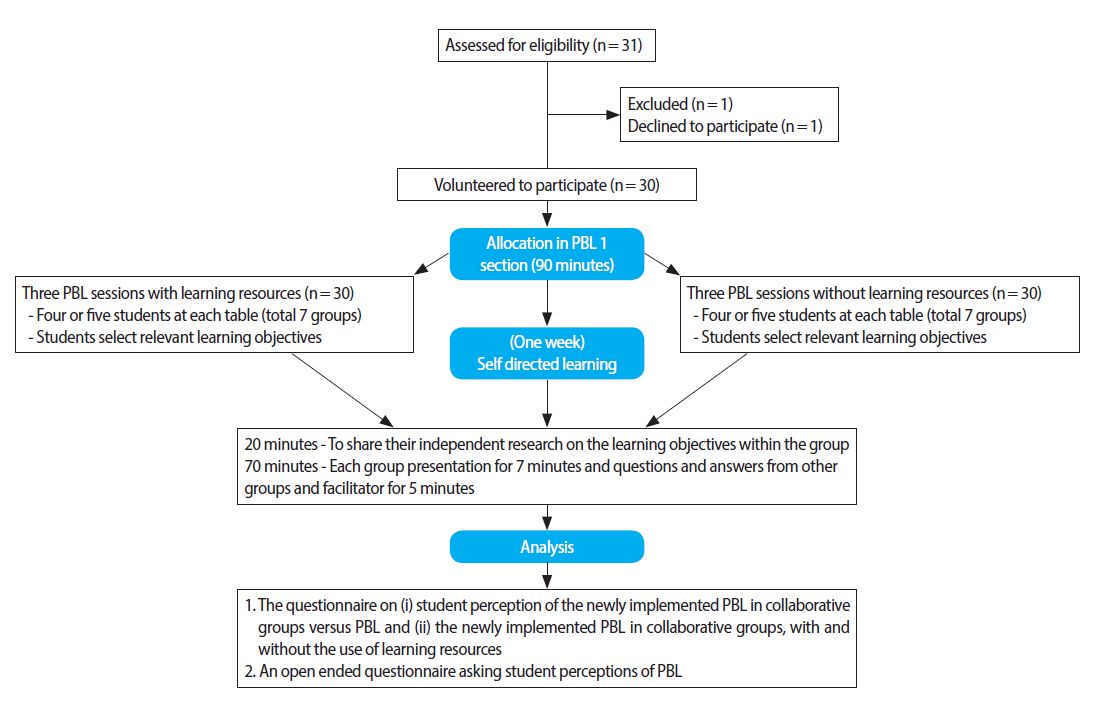J Educ Eval Health Prof.
2015;12:17. 10.3352/jeehp.2015.12.17.
The implementation of problem-based learning in collaborative groups in a chiropractic program in Malaysia
- Affiliations
-
- 1International Medical University, Kuala Lumpur, Malaysia. vishnadevi_nadarajah@imu.edu.my
- KMID: 2402024
- DOI: http://doi.org/10.3352/jeehp.2015.12.17
Abstract
- PURPOSE
Problem-based learning (PBL) is usually conducted in small-group learning sessions with approximately eight students per facilitator. In this study, we implemented a modified version of PBL involving collaborative groups in an undergraduate chiropractic program and assessed its pedagogical effectiveness.
METHODS
This study was conducted at the International Medical University, Kuala Lumpur, Malaysia, and involved the 2012 chiropractic student cohort. Six PBL cases were provided to chiropractic students, consisting of three PBL cases for which learning resources were provided and another three PBL cases for which learning resources were not provided. Group discussions were not continuously supervised, since only one facilitator was present. The students' perceptions of PBL in collaborative groups were assessed with a questionnaire that was divided into three domains: motivation, cognitive skills, and perceived pressure to work.
RESULTS
Thirty of the 31 students (97%) participated in the study. PBL in collaborative groups was significantly associated with positive responses regarding students' motivation, cognitive skills, and perceived pressure to work (P<0.05). The students felt that PBL with learning resources increased motivation and cognitive skills (P<0.001).
CONCLUSION
The new PBL implementation described in this study does not require additional instructors or any additional funding. When implemented in a classroom setting, it has pedagogical benefits equivalent to those of small-group sessions. Our findings also suggest that students rely significantly on available learning resources.
Keyword
MeSH Terms
Figure
Reference
-
1. Nicholl TA, Lou K. A model for small-group problem-based learning in a large class facilitated by one instructor. Am J Pharm Educ. 2012; 76:117. http://dx.doi.oprg/10.5688/ajpe766117.
Article2. Pastirik PJ. Using problem-based learning in a large classroom. Nurse Educ Pract. 2006; 261–267. http://dx.doi.org/10.1016/j.nepr.2006.02.003.
Article3. Klegeris A, Hurren H. Impact of problem-based learning in a large classroom setting: student perception and problem-solving skills. Adv Physiol Educ. 2011; 35:408–415. http://dx.doi.org/10.1152/advan.00046.2011.
Article
- Full Text Links
- Actions
-
Cited
- CITED
-
- Close
- Share
- Similar articles
-
- From crisis to opportunity: enhancing anatomy education in a post-COVID world: the Universiti Sains Malaysia experience
- Fostering critical thinking and collaborative learning skills among medical students through a research protocol writing activity in the curriculum
- Implementation of a Problem-Based Learning Program Combined with Team-Based Learning
- An Implementation and an Evaluation on the Problem-based Learning in Occupational & Environmental Medicine(OEM)
- Implementation of Problem-based Learning to Established Medical Schools with Insufficient Resources


